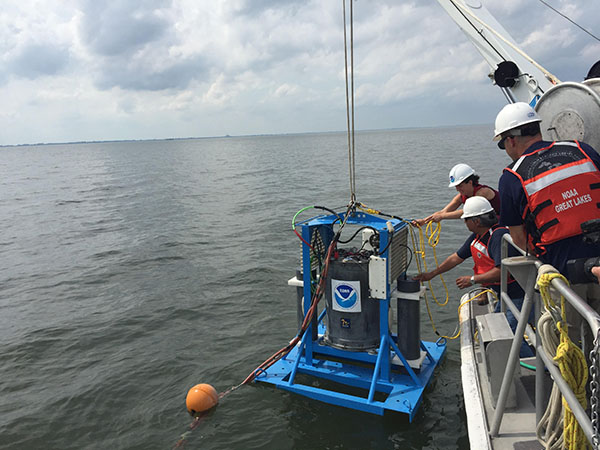In FY 2017, the U.S. IOOS Program (IOOS®) continued the Ocean Technology Transition (OTT) project by awarding three multi-year grants totaling $1.3 million to enhance public health, risk management, and operational efficiency in ocean observing.

The ESPniagara, ready for deployment at the start of HAB season 2017. ESPs, or Environmental Sample Processors, were sponsored from development to operations by a previous OTT grant. Photo: NOAA/GLERL
The Gulf of Maine Lobster Foundation was awarded a 2-year grant to Operationalize Real-time Telemetry Onboard Commercial fishing vessels in the Northeast. This project will involve working with NOAA’s Northeast Fisheries Science Center, the U.S. IOOS Northeastern Regional Association of Coastal and Ocean Observing Systems, Fishermen and Scientist Research Society, the Island Institute, Commercial Fisheries Research Foundation, and the Woods Hole Oceanographic Institution to install 36 real-time sensors on commercial fishing boats to collect ocean data, including temperature and depth. The Gulf of Maine Research Institute will support the data management and display work. This project, once completed, will significantly increase the availability of bottom temperature data used by the fishing community to improve their catch. The project is also expected to improve the forecasting capability of local ocean circulation modelers, the National Weather Service, and the U.S. Coast Guard, which will enable better decisions for those living and working on the water.
- The Year 1 total for this award is $399,423.
The University of California Santa Cruz (UCSC) Department of Ocean Sciences was awarded a 3-year grant to transition a Real-time Monitoring of the Impact of Observing Systems on Ocean Analysis-Forecast Systems in Support of U.S. IOOS into Operations. The current ocean observing system comprises satellite measurements of surface properties such as sea surface temperature, sea surface height, and ocean color, as well as in situ observing systems, many of which are managed and maintained by U.S. IOOS and its Regional Associations (RAs). In partnership with U.S. IOOS’ Central and Northern California Coastal and Ocean Observing System, Pacific Islands Ocean Observing System and Mid-Atlantic Regional Association of Coastal and Ocean Observing Systems and with the University of Hawaii, Rutgers University, and RPSGroup Inc./Applied Science Associates this project will focus on advancement of the Regional Ocean Modeling System 4-dimensional variational data assimilation system’s diagnostic tools to assess the impact of IOOS’ observations on analysis and forecasts that address ocean, coastal, and Great Lakes observing, product, development, and data management challenges to support future enhancements to IOOS. This project will provide a new ability to analyze the observing assets of the IOOS system in a new and unique way that will enable prioritization of observing system assets and technologies toward improving overall operational efficiency of IOOS investments.
- The Year 1 total for this award is $414,855.
The Great Lakes Observing System was awarded a 3-year grant to Transition Lake Erie Harmful Algal Blooms Early Warning System to Sustainable Operational Form. Harmful Algal Blooms (HAB) in general, and cyanobacterial harmful algal blooms (cHABs) in freshwater in particular, are a global public health and environmental concern. This project will deploy Environmental Sample Processors to enhance the collection and distribution of microcystin toxin measurements from Lake Erie to Ohio water plant managers and other regional stakeholders before toxic blooms arrive at drinking water intakes. The project will also update the Lake Erie HABs Data Portal to enhance the distribution of HAB data from the operational real-time sensor network and a related research sampling and monitoring network in Lake Erie to water plan managers and decision makers. Project partners include NOAA’s Great Lakes Environmental Research Lab and Center for Coastal Environmental Health & Biomolecular Research, LimnoTech, the Cleveland Water Alliance, and numerous universities and water utilities in the area.
- The Year 1 total for this award is $714,000.
The Ocean Technology Transition project sponsors the transition of emerging marine observing technologies, for which there is an existing operational requirement and a demonstrated commitment to integration and use by the ocean observing community, to operational mode. The primary objective of IOOS’ OTT project is to reduce the "research to operations" transition period for ocean observing, product development, and data management technologies for the ocean, coastal and Great Lakes. The term ‘technologies’ includes: ocean, coastal, and Great Lakes sensors, Information Technology (data management, data visualization, model transition); platform enhancement, and technology modernization efforts. Marine observation technologies include hardware and software platforms, sensors, and data transfer technologies that collect observations in the marine and Great Lakes environments. This objective is accomplished by investing in the transition of emerging and promising marine and Great Lakes observing technological capabilities from the mid to latter phases of research into operational status.
 Official websites use .gov
A .gov website belongs to an official government organization in the United States.
Official websites use .gov
A .gov website belongs to an official government organization in the United States.
 Secure .gov websites use HTTPS
A lock or https:// means you’ve safely connected to the .gov website. Share sensitive information only on official, secure websites.
Secure .gov websites use HTTPS
A lock or https:// means you’ve safely connected to the .gov website. Share sensitive information only on official, secure websites.
